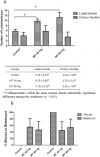Melatonin promotes superovulation in sika deer (Cervus nippon)
- PMID: 25007067
- PMCID: PMC4139832
- DOI: 10.3390/ijms150712107
Melatonin promotes superovulation in sika deer (Cervus nippon)
Abstract
In this study, the effects of melatonin (MT) on superovulation and reproductive hormones (melatonin, follicle-stimulating hormone (FSH), luteinizing hormone (LH) and PRL) were investigated in female sika deer. Different doses (40 or 80 mg/animal) of melatonin were subcutaneously implanted into deer before the breeding season. Exogenous melatonin administration significantly elevated the serum FSH levels at the time of insemination compared with levels in control animals. During superovulation, the serum LH levels in donor sika deer reached their highest values (7.1±2.04 ng/mL) at the point of insemination, compared with the baseline levels (4.98±0.07 ng/mL) in control animals. This high level of LH was sustained until the day of embryo recovery. In contrast, the serum levels of PRL in the 80 mg of melatonin-treated group were significantly lower than those of control deer. The average number of corpora lutea in melatonin-treated deer was significantly higher than that of the control (p<0.05). The average number of embryos in the deer treated with 40 mg of melatonin was higher than that of the control; however, this increase did not reach significant difference (p>0.05), which may be related to the relatively small sample size. In addition, embryonic development in melatonin-treated groups was delayed.
Figures





Similar articles
-
Assessment LOPU-IVF in Japanese sika deer (Cervus nippon nippon) and application to Vietnamese sika deer (Cervus nippon pseudaxis) a related subspecies threatened with extinction.Theriogenology. 2012 Dec;78(9):2039-49. doi: 10.1016/j.theriogenology.2012.07.025. Epub 2012 Oct 5. Theriogenology. 2012. PMID: 23043947
-
Serum hormone concentrations and ovarian follicular wave emergence in Jilin sika deer (Cervus nippon hortulorum) after synchronization of estrous cycles.Anim Reprod Sci. 2015 Feb;153:44-9. doi: 10.1016/j.anireprosci.2014.11.017. Epub 2014 Dec 27. Anim Reprod Sci. 2015. PMID: 25563157 Clinical Trial.
-
First live offspring born in superovulated sika deer (Cervus nippon) after embryo vitrification.Theriogenology. 2012 Oct 15;78(7):1627-32. doi: 10.1016/j.theriogenology.2012.07.008. Theriogenology. 2012. PMID: 22980091
-
Endocrine profiles and embryo quality in Japanese black cattle superovulated with human menopausal gonadotrophin and porcine follicle stimulating hormone.Reprod Domest Anim. 2001 Apr;36(2):57-63. doi: 10.1046/j.1439-0531.2001.00192.x. Reprod Domest Anim. 2001. PMID: 11328557
-
Superovulation in cattle: practical aspects of gonadotropin treatment and insemination.Reprod Nutr Dev. 2002 Nov-Dec;42(6):587-99. doi: 10.1051/rnd:2002045. Reprod Nutr Dev. 2002. PMID: 12625423 Review.
Cited by
-
Exogenous Melatonin Improves the Reproductive Outcomes of Yearling Iberian Red Deer (Cervus elaphus hispanicus) Hinds.Animals (Basel). 2021 Jan 18;11(1):224. doi: 10.3390/ani11010224. Animals (Basel). 2021. PMID: 33477633 Free PMC article.
-
The effect of melatonin implants on the embryo yield and oxidative stress levels in superovulated Holstein heifers.Vet Res Commun. 2025 Jun 24;49(4):236. doi: 10.1007/s11259-025-10807-8. Vet Res Commun. 2025. PMID: 40553391
-
Melatonin Regulates the Synthesis of Steroid Hormones on Male Reproduction: A Review.Molecules. 2018 Feb 17;23(2):447. doi: 10.3390/molecules23020447. Molecules. 2018. PMID: 29462985 Free PMC article. Review.
-
Effect of pre-treatment of melatonin on superovulation response, circulatory hormones, and miRNAs in goats during environmental heat stress conditions.Vet Res Commun. 2024 Feb;48(1):459-474. doi: 10.1007/s11259-023-10239-2. Epub 2023 Oct 13. Vet Res Commun. 2024. PMID: 37831382
-
Melatonin improves the efficiency of super-ovulation and timed artificial insemination in sheep.PeerJ. 2019 Apr 25;7:e6750. doi: 10.7717/peerj.6750. eCollection 2019. PeerJ. 2019. PMID: 31086729 Free PMC article.
References
-
- Zhang L., Chai M., Tian X., Wang F., Fu Y., He C., Deng S., Lian Z., Feng J., Tan D.X., et al. Effects of melatonin on superovulation and transgenic embryo transplantation in small-tailed han sheep (Ovis aries) Neuro Endocrinol. Lett. 2013;34:294–301. - PubMed
-
- Forcada F., Abecia J.A., Cebrian-Perez J.A., Muino-Blanco T., Valares J.A., Palacin I., Casao A. The effect of melatonin implants during the seasonal anestrus on embryo production after superovulation in aged high-prolificacy Rasa Aragonesa ewes. Theriogenology. 2006;65:356–365. doi: 10.1016/j.theriogenology.2005.05.038. - DOI - PubMed
Publication types
MeSH terms
Substances
LinkOut - more resources
Full Text Sources
Other Literature Sources

